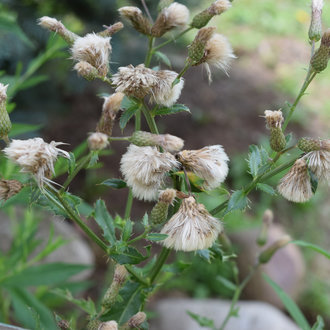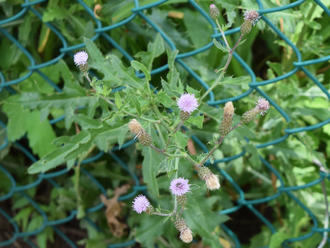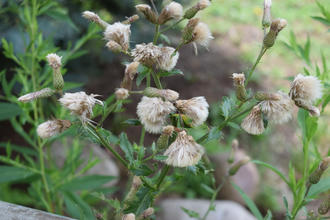Creeping Thistle (Cirsium arvense (L.) Scop.)
Also known as Canada thistle, spreading thistle, field thistle.
↑Summary
A perennial species of thistle native to Europe and northern Asia, and introduced in North America where it is considered invasive. The widely-used common name "Canada thistle" is misleading as this species is not native to Canada; for this reason we recommend using other common names or the scientific name to refer to this plant.
↑Range - Expand
| Legend | Color |
| Introduced | |
| Introduced or Not Present |
This tentative map is based on our own research. It may have limited data on Canada and/or Mexico, and there is some subjectivity in our assignment of plants as introduced vs. expanded. Read more in this blog post.
Although this plant occurs somewhere in each of these regions, it may only occur in a small part of some or all of them.
↑Habitat
Prefers full sun to light shade, moist to average conditions, and fertile soil. In North America, mostly found in anthropogenic habitats, such as croplands, gardens, roadsides and railroads, and disturbed urban areas where mowing removes competing vegetation, but also found in more natural prairie, meadow, and grassland habitats.
↑Life Cycle
Sprouts from seed and establishes a basal rosette and taproot; young plants require high light levels for germination and survival, but established plants are tolerant of light shade. During warm weather, quickly begins upright growth.
Flowers early to mid summer, followed by seed production. Seeds are wind-dispersed. Foliage persists long after flowering has finished.
Invests most of its growth in vegetative reproduction, spreading by underground rhizomes to form large colonies.
Resprouts vigorously in response to being cut.
This plant benefits hugely from modern landscaping practices, especially mulching and weed-whacking. Mulching holds moisture and provides nutrient-rich conditions in which this plant thrives, whereas it is tolerant of repeated cutting to the ground due to investing most of its energy in underground growth, but its ability to quickly resprout causes it to benefit from the removal of competing vegetation.
↑Control
Creeping thistle is one of the more difficult plants to control once it is established on a site, but it can be removed with persistence. Because it is strongly rhizomatous, it resprouts vigorously if mowed or even if uprooted. Learning to quickly spot and identify seedlings can be a low-effort way to prevent its establishment and reduce the need for greater work later.
Systemic herbicides can be effective for controlling large patches of this plant, but care must be taken not to kill competing native vegetation, as this plant will readily recolonize sites with suitable soil conditions and no competition. Herbicide is most effective if only used where this plant forms a monoculture, and then selective pulling of individual plants is used where it is growing among desirable plants. As with most rhizomatous plants, herbicide is most effective when applied later in the growing season when the plants are cycling energy back into the roots. Herbicide is also more effective if applied to plants already weakened by mowing or pulling.
When uprooting this plant, it is easier effective to allow it to grow to full or almost full height as then it can be pulled while removing much of the attached root system, with less effort. Digging out the root of plants earlier in the growing season requires a trowel or shovel and is often more labor-intensive and less effective. Plants will resprout from rhizomes, but each resprout will be progressively less vigorous, and plants will eventually be overtaken by competing vegetation to where only minimum effort is require to pull the occasional straggler.
Large patches of this plant can also be reduced by mowing them repeatedly, ideally just as they are beginning to form flower buds. Although plants can survive isolated mowing, and may even thrive in a once-a-season mowing regime, they cannot survive repeated mowing.
In the long-run, minimizing your use of mulch in landscaping, can help reduce the chance of this plant establishing and dominating. Plants establish readily from wind-blown seeds in mulch, and mulch provides ideal conditions for this plant to quickly form a massive, robust patch. Landscaping practices with abundant empty space and exposed mulch or soil between plants also promote the establishment of this plant. Denser plant growth, and the use of groundcovers to fill in all empty space, can effectively prevent this plant's establishment by seed, and can also hinder its ability to expand vegetatively.
↑Links & External Resources
• Canada Thistle | Fire Effects Information System (FEIS) (About This Site)
• Cirsium arvense (Canada Thistle) | Illinois Wildflowers (About This Site)
• Cirsium arvense (Creeping Thistle) | USDA PLANTS Database (About This Site)
• Cirsium arvense | Go Botany (About This Site)
• Cirsium arvense | Biota of North America Project (BONAP) (About This Site)
• Cirsium arvense | NatureServe Explorer (About This Site)
• Cirsium arvense | Flora of North America (About This Site)
• Cirsium arvense | Missouri Plants (About This Site)
• Canada Thistle | Maryland Biodiversity Project (About This Site)
• Cirsium arvense (Canada Thistle) | Minnesota Wildflowers (About This Site)
• Cirsium arvense (L.) Scop. (Canada Thistle, Field Thistle) | Digital Atlas of the Virginia Flora (About This Site)
• Cirsium arvense (L.) Scop. var. horridum Wimmer & Graebner (Canada Thistle, Field Thistle) | Digital Atlas of the Virginia Flora (About This Site)
• Cirsium arvense (L.) Scop. var. arvense (Canada Thistle, Field Thistle) | Digital Atlas of the Virginia Flora (About This Site)





